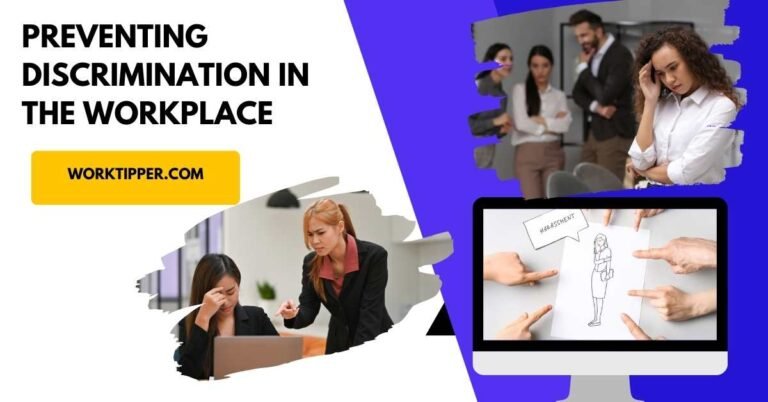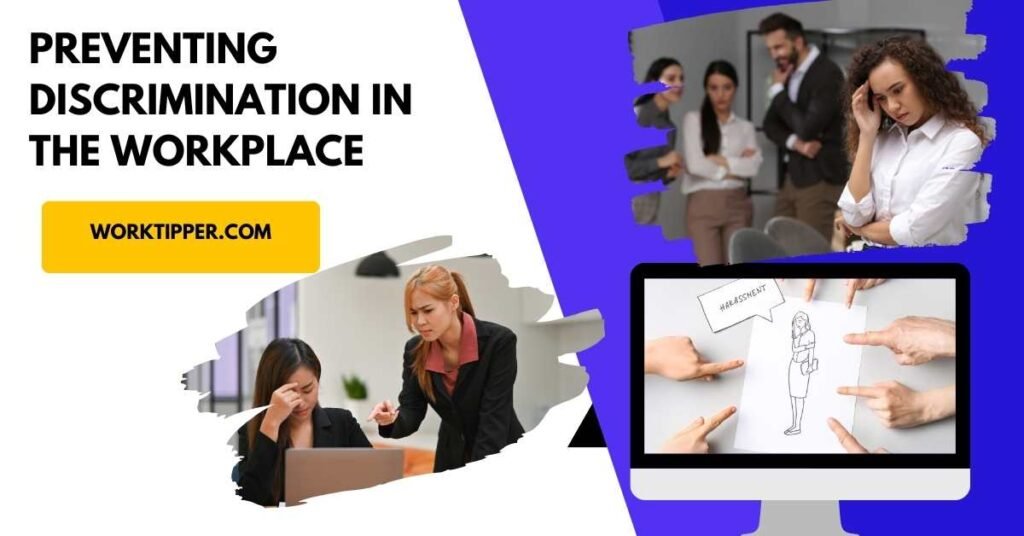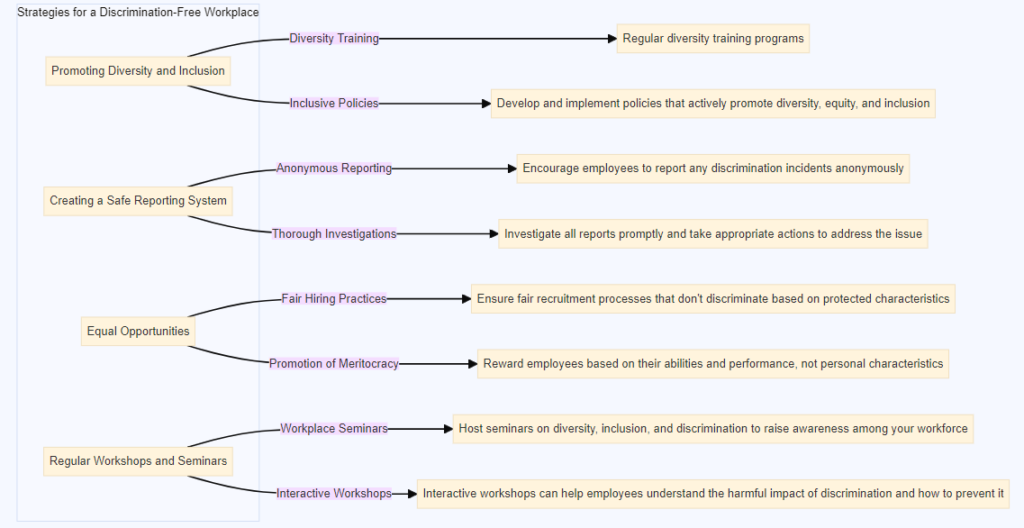
In our pursuit to create an inclusive and harmonious work environment, we believe that preventing discrimination in the workplace is not just a choice but a fundamental necessity. In this guide, we delve deep into the strategies and practices that can help you establish a discrimination-free workplace, thus ensuring your organization’s success and well-being of your employees.

Understanding Workplace Discrimination
Discrimination, in any form, poses a substantial threat to a company’s reputation and employee morale. It is essential to start by comprehending the various dimensions of workplace discrimination, which include:
Types of Discrimination
1. Direct Discrimination
Direct discrimination occurs when someone is treated unfairly due to their protected characteristics. These protected characteristics can encompass gender, age, race, disability, and more. Preventing this type of discrimination is paramount to maintaining a fair and just workplace where every employee is treated with respect and equality.
2. Indirect Discrimination
Indirect discrimination takes place when workplace policies or practices, while appearing neutral on the surface, disproportionately affect individuals with specific characteristics. Identifying and rectifying instances of indirect discrimination is vital to creating a truly equitable workplace where no one feels marginalized.
The Legal Framework
Understanding the legal aspects of discrimination in the workplace is of utmost importance. Familiarizing your organization with the laws and regulations in place is the first step towards effective prevention. Compliance with anti-discrimination laws is not only ethically sound but also legally mandatory.
Strategies for Preventing Discrimination in the Workplace

Now, let’s explore some concrete steps and strategies that can help you prevent discrimination in your organization effectively. These strategies are not only vital for the well-being of your employees but also for the success and growth of your business.
1. Promoting Diversity and Inclusion
- Diversity Training: Regular diversity training programs can help your employees understand the value of differences and foster a more inclusive atmosphere. These training sessions should cover topics like bias awareness, cultural sensitivity, and respect for individual identities.
- Inclusive Policies: Develop and implement policies that actively promote diversity, equity, and inclusion in your organization. These policies should be clearly communicated to all employees and serve as a foundation for fostering an inclusive workplace culture.
2. Creating a Safe Reporting System
- Anonymous Reporting: Encourage your employees to report any discrimination incidents anonymously. An anonymous reporting system ensures their protection and encourages individuals to come forward without fear of retaliation.
- Thorough Investigations: Investigate all reports promptly and take appropriate actions to address the issue. Ensure that investigations are thorough, unbiased, and conducted by trained professionals. Transparency in the investigative process is essential for building trust.
3. Equal Opportunities
- Fair Hiring Practices: Ensure that your recruitment processes are fair and do not discriminate based on protected characteristics. Develop standardized interview questions and evaluation criteria to promote a level playing field for all candidates.
- Promotion of Meritocracy: Reward employees based on their abilities and performance, not their personal characteristics. Implement performance appraisal systems that are transparent and based on merit, ensuring that opportunities for advancement are open to all.
4. Regular Workshops and Seminars
- Workplace Seminars: Host seminars on diversity, inclusion, and discrimination to raise awareness among your workforce. These seminars should be interactive, engaging, and tailored to the specific needs of your organization.
- Interactive Workshops: Interactive workshops can help employees understand the harmful impact of discrimination and how to prevent it. These workshops can include role-playing exercises, group discussions, and case studies to make the learning experience more immersive.
Benefits of a Discrimination-Free Workplace
A workplace that actively prevents discrimination can reap a myriad of benefits, all of which contribute to a healthier, more prosperous, and harmonious organizational environment. Let’s delve deeper into these advantages:
- Increased Productivity:
When employees work in an environment where they feel safe, valued, and respected, they are more likely to be deeply engaged in their tasks. The elimination of discrimination creates a sense of belonging and trust, which, in turn, leads to improved concentration and a higher level of job satisfaction. Employees who are not burdened by the stress and distraction of discrimination can channel their energy and focus into their work, resulting in higher productivity levels. This increase in productivity benefits both the individual employees and the organization as a whole, ultimately leading to the accomplishment of business objectives more efficiently. - Enhanced Reputation:
A workplace that actively prevents discrimination not only fosters a positive atmosphere for its employees but also enhances its external reputation. When an organization is known for promoting a fair and inclusive working environment, it becomes an attractive destination for top talent. Skilled individuals are drawn to companies that prioritize diversity, equity, and inclusion, as they see these organizations as places where their talents and contributions will be recognized and valued. Moreover, a positive reputation for inclusivity can extend beyond the workforce and appeal to a broader customer base. Customers are increasingly making choices based on the values and practices of the companies they support. An organization with a reputation for inclusivity is more likely to resonate with consumers who appreciate and support diversity. - Legal Protection:
Adhering to anti-discrimination laws and regulations serves as a safeguard against costly legal disputes and potential reputation damage. Compliance with these laws is not only a legal requirement but also a moral and ethical imperative. Organizations that prioritize discrimination prevention are less likely to face legal challenges related to discrimination, harassment, or bias. Avoiding legal battles protects the organization from fines, penalties, and costly settlements, thereby preserving its financial integrity and reputation. It’s important to recognize that the cost of non-compliance with anti-discrimination laws goes beyond financial implications; it can also severely damage the organization’s image and standing in the community and industry. - Improved Employee Retention:
A workplace that actively combats discrimination significantly boosts employee satisfaction and retention rates. When employees feel respected, included, and valued for their unique attributes and contributions, they are more inclined to develop a strong attachment to the organization. This emotional connection to the workplace fosters loyalty and a sense of commitment, reducing turnover rates. Higher retention rates, in turn, translate into cost savings, as recruiting, onboarding, and training new employees are resource-intensive processes. A discrimination-free environment can lead to a positive cycle where happy and engaged employees stay longer, reducing the need for constant recruitment and minimizing associated costs.
Conclusion
In conclusion, preventing discrimination in the workplace is an ongoing commitment that requires a combination of policies, training, and a corporate culture that values diversity and inclusivity. By implementing the strategies discussed in this guide, you can create an environment where employees are free from discrimination, and your organization can thrive as a result. Remember, a discrimination-free workplace is not just a choice; it’s a fundamental necessity for the success and well-being of your employees and your organization as a whole. Embrace diversity, promote inclusion, and ensure that your workplace is a safe haven for everyone.